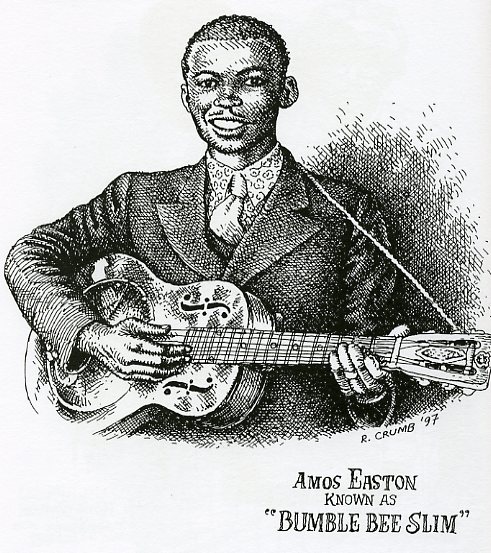“Bumble Bee Slim” Easton was a prolific singer and songwriter whose relaxed, upbeat style and often humorous lyrics made him one of the most-recorded and best-selling blues artists of the 1930s. His work exemplifies the beginnings of what came to be known as the Chicago style, retaining elements of earlier country blues while anticipating the more polished urban sounds of the postwar period.

Courtesy of Hargrett Rare Book and Manuscript Library, University of Georgia Libraries.
Bumble Bee Slim was born Amos Easton in Brunswick on May 7, 1905. One of six children, he was four years old when his father died. His mother remarried, and Easton began working in the fields soon afterward. At age nine he made his first attempt to leave home, setting up a stand where he cut hair and sold peanuts until his family found him and brought him back. When he was about fifteen, Easton joined the Ringling Brothers’ circus and traveled around the South and Midwest for two years. Returning to Georgia, he worked at a variety of jobs and was married briefly before heading north on a freight train.
In 1928 he settled in Indianapolis, Indiana, where he met pianist Leroy Carr, who with guitarist Scrapper Blackwell formed one of the most innovative blues duos of the period. Easton, now using the stage name Bumble Bee Slim, was impressed by Carr’s light, expressive singing and by Blackwell’s guitar technique, and their influence can be heard throughout Slim’s work. After refining his skills by playing halls and rent parties, Slim moved to Chicago. In 1931 he made his first recordings for Paramount Records, and the following year his song”B&O Blues” was a hit for Vocalion Records, inspiring a number of other railroad blues and eventually becoming a popular folk song.
Between 1934 and 1937 Slim recorded more than 150 titles. His wry, streetwise songs, while not particularly innovative, reflect the realities of African American life during the Great Depression and convey the warmth and resilience of Slim’s personality. During this period Slim released two or three records a month for the Decca, Bluebird, and Vocalion labels, often accompanied by such skillful musicians as Big Bill Broonzy, Memphis Minnie, and Peetie Wheatstraw. In contrast to the raw, emotional blues of earlier artists, Slim’s material and vocal delivery were light and even frivolous, an approach welcomed by many listeners during the hard times of the depression.
By 1937 Slim had become frustrated with the limitations of the piano/guitar arrangements imposed on him by his record labels, as well as by the limited income he was receiving from his work. He returned to Georgia, then relocated to Los Angeles, California, in the early 1940s, apparently hoping to break into motion pictures as a songwriter and comedian. He soon went back to blues music, however. During the 1950s he recorded several albums, but these made little impact in a marketplace dominated by the new rhythm-and-blues sound. In an effort to cross over to the growing white audience for blues, he recorded his final album with jazz musicians, but it too failed to sell. Slim continued to perform in clubs around Los Angeles until his death. He is believed to have died in early 1968.
His Complete Recorded Works have been reissued on several CDs by the Document label.





